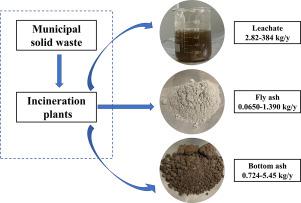Science of the Total Environment ( IF 8.2 ) Pub Date : 2021-06-24 , DOI: 10.1016/j.scitotenv.2021.148468 Shanshan Liu 1 , Shiyi Zhao 1 , Zhihong Liang 2 , Fei Wang 1 , Feiyun Sun 3 , Da Chen 1

|
Perfluoroalkyl substances (PFASs) are a family of chemicals widely distributed in daily use consumer products. Most of these products become municipal solid wastes (MSWs) after they have been used. In the present study, we examined different types of PFASs in leachate, fly ash and bottom ash produced from three MSW incineration plants in southern China. High PFAS levels were found in leachate (mean concentration 215 ng/mL, range 21.4–682 ng/mL) from the incineration plants, which indicated large amounts of PFASs in the wastes leached out. The average quantities of PFASs annually discharged from the leachates of the three plants were estimated to be approximately 384 kg (Plant A), 47.3 kg (Plant B), and 2.82 kg (Plant C). Relatively lower levels of PFASs in fly ash (mean 16.4 ng/g, range 1.46–87.6 ng/g) and bottom ash (mean 14.6 ng/g, range 3.11–77.4 ng/g) indicated that high-temperature incineration destroyed most of the PFASs. The wide array of PFASs concentrations in all three matrices illustrated that some PFASs-containing industrial wastes were still entered into local MSW. In general, short chain PFASs, including perfluorobutyric acid (PFBA) and perfluorobutane sulfonate (PFBS), were the primary PFASs in leachate samples. In addition, PFOS was the predominant PFASs in fly ash samples. The results showed that leachate, fly ash, and bottom ash from MSW incineration plants are important vectors of PFASs.


















































 京公网安备 11010802027423号
京公网安备 11010802027423号